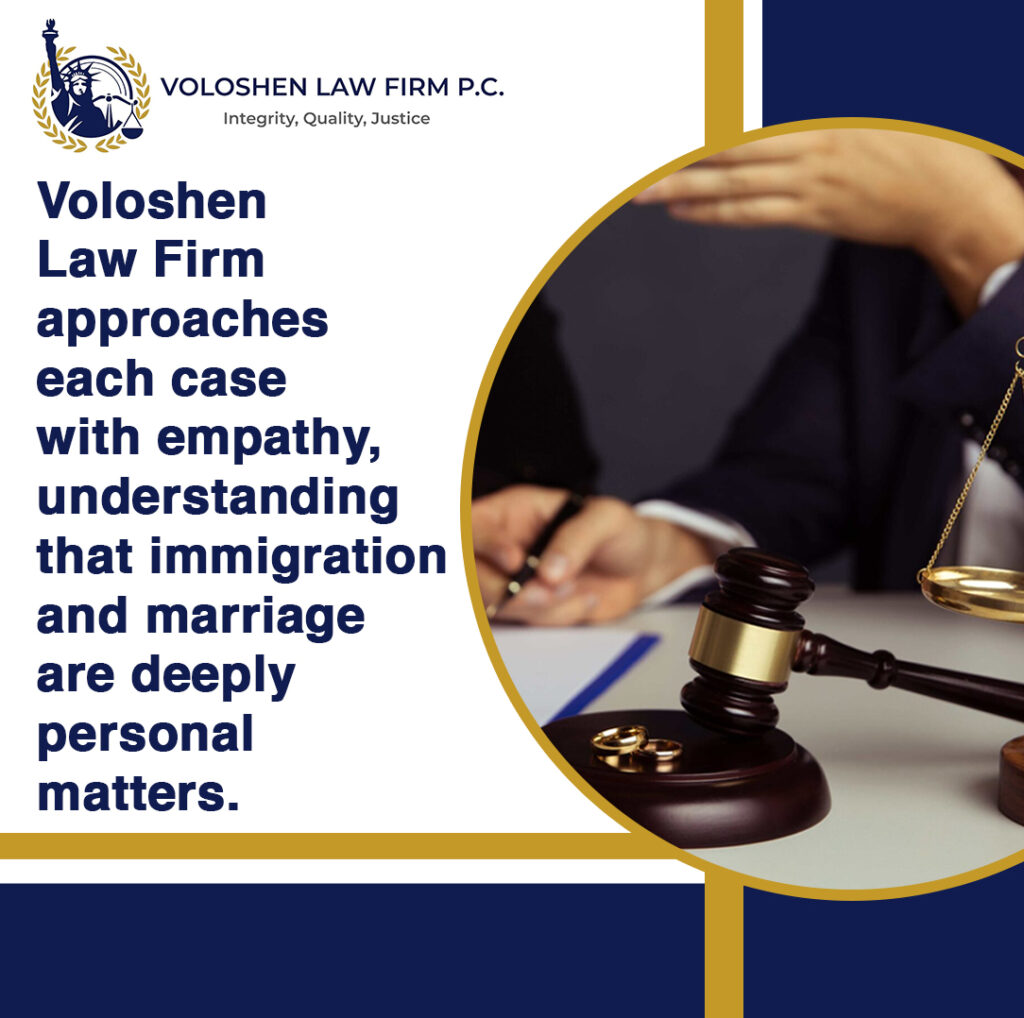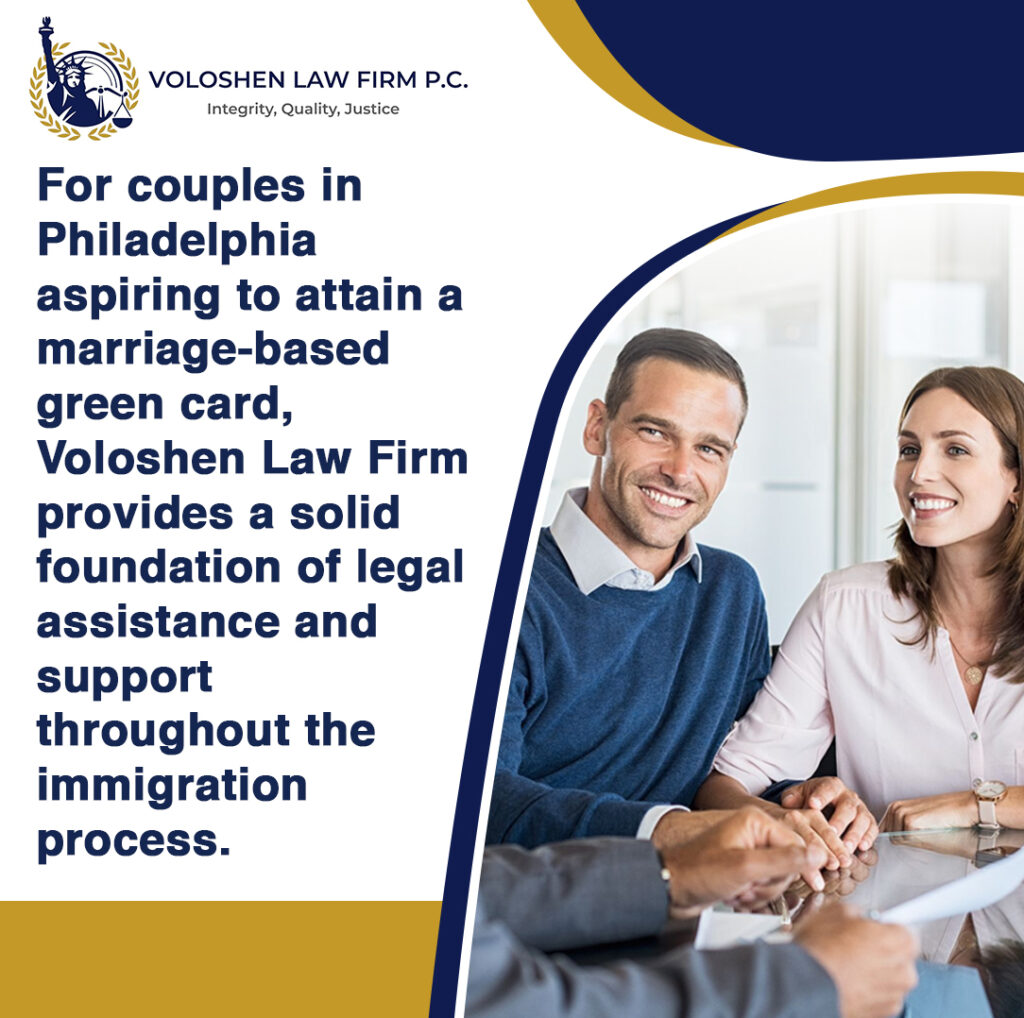Obtaining a marriage-based green card can be overwhelming, especially for couples in Philadelphia navigating the complex immigration process for the first time. Many seek the ability to live and work together in the U.S., but uncertainties often arise regarding the requirements and implications of the process.
At Voloshen Law Firm P.C., we understand the complexities of the marriage-based green card process. Our experienced immigration lawyers are committed to offering personalized support and guiding couples through the unique challenges they may face. We know that the emotional investment in securing a green card can be significant, as it impacts not just immediate plans but also long-term aspirations for a shared future.
We emphasize open communication with our clients, offering an approachable environment where questions and concerns can be freely expressed. This makes sure that couples feel understood and supported as they navigate the complexities of immigration law.
In a diverse city like Philadelphia, the stakes are high as many couples dream of building families and a life together in the U.S. Our mission is to make that dream attainable with integrity, quality representation, and a steadfast commitment to justice. On top of that, staying informed about the ever-changing landscape of immigration law is vital, and our team is devoted to providing you with up-to-date insights that matter for your case.
As you begin this journey, remember that you do not have to face it alone. Voloshen Law Firm in Huntingdon Valley, Pennsylvania, is here to guide you with expertise and support, helping bring you and your spouse closer to achieving your aspirations in America, all while adhering to our motto: Integrity, Quality, and Justice.
Understanding Marriage-Based Green Cards

At the core of your journey is understanding what a marriage-based green card entails. Obtaining this type of green card allows a non-U.S. citizen to live and work in the United States as a lawful permanent resident through marriage to a U.S. citizen or a permanent resident. Understanding this process requires clarity and a solid grasp of the eligibility criteria and necessary steps.
Step 1: Confirm Eligibility
The process begins by confirming that both you and your spouse fulfill the criteria for a marriage-based green card. To be eligible, you must be lawfully married to a U.S. citizen or a legal permanent resident. This includes verifying that any past marriages have been formally ended. If your marriage took place outside the United States, such as in India, there is no need to register it in the U.S.; however, you must submit a marriage certificate proving the union was legally recognized in the country where it occurred.
Additionally, your marriage must be genuine and not solely for immigration purposes. Make sure your marriage is genuine and not solely intended for immigration purposes. Gather and present documentation that demonstrates the authenticity of your relationship, such as shared financial records, photos, and statements from friends or family members.
Step 2: Collect Necessary Documentation
After determining your eligibility, the next step involves gathering the necessary documentation. Organizing all required materials can make a substantial difference in how smoothly your application proceeds. Here’s a list of essential forms you will need to prepare:
- Form I-130: Alien Relative Petition: This form establishes the qualifying relationship between the petitioner (a U.S. citizen or lawful permanent resident) and the beneficiary. For spouses of U.S. citizens, visas are immediately available, which can expedite the process. Make sure that the I-130 is completed accurately and includes all required documentation, such as your marriage certificate.
- Application to Register Permanent Residence or Modify Status (Form I-485): The beneficiary can apply for a green card while still in the U.S. by completing the I-485. It needs full disclosure of the applicant’s past, such as biographical information, immigration records, and the outcomes of any medical exams.
- Affidavit of Support, Form I-864: With the use of this legal agreement, the petitioner proves that they have the resources to sustain the beneficiary and keep them from becoming a public liability. It must include evidence such as tax returns, W-2 forms, and proof of income to meet the minimum financial requirements.
- Form I-765: Application for Employment Authorization (if applicable): Filing the I-765 allows the beneficiary to work legally in the U.S. while their green card application is pending. This form is optional but highly beneficial for those seeking to maintain financial stability during the application process.
Additionally, be ready to provide supporting documentation, including:
- Marriage Certificate: As proof of your legal union. If the certificate is in a language other than English, it must be accompanied by a certified English translation.
Proof of Spouse’s Status: Documents like a U.S. passport, birth certificate, naturalization certificate, or green card.
- Evidence of a Genuine Relationship: Acceptable examples include:
- Joint bank account statements.
- Photographs from different stages of your relationship.
- Shared rental or mortgage agreements.
- Affidavits from friends or family attesting to the authenticity of your marriage.
- Travel records, correspondence, or other materials that illustrate a shared life together.
- Personal Identification Documents: Birth certificates and passport copies for both spouses.
This step is vital, as both spouses must actively participate in gathering the necessary documents. Keeping communication open can help streamline this process.
Step 3: Filing the I-130 Petition
The next important step after finishing your paperwork is to file Form I-130, Petition for Alien Relative. As it formally certifies the validity of your marriage and your eligibility for a spouse-based green card, this form forms the foundation of your application.
You must provide supporting documentation to demonstrate the validity of your marriage together with Form I-130. Photos of you and your spouse together, shared financial records, such as bank accounts or leases, and statements from friends and relatives confirming the sincerity of your relationship could all be examples of this. It’s critical to make sure that all supporting documentation is appropriately arranged and displayed.
The filing process differs depending on where your spouse is located. If they are in the U.S., your petition is processed by U.S. Citizenship and Immigration Services (USCIS). If they are outside the U.S., the petition will be handled by the National Visa Center (NVC), which will eventually forward the case to the appropriate U.S. Embassy or Consulate for the next steps.
At Voloshen Law Firm, our experienced immigration attorneys are here to help you navigate the complexities of filing Form I-130. We ascertain that the form is correctly completed, along with the appropriate documentation, so your petition is submitted accurately and on time. Any errors or missing information could lead to delays or potential denials, so the application must be thorough and complete.
Step 4: Await Approval of the I-130 Petition
After submitting the I-130 petition, patience is essential. Processing times vary, and waiting for approval can be uncertain. Regularly check USCIS processing times or contact our office to stay informed. Once your petition is approved, you can move forward in the process.
Step 5: Filing the I-485 Application
Filing Form I-485, the Application to Register Permanent Residence or Adjust Status, is an important next phase once your I-130 petition has been approved. Foreign spouses who are already in the United States use this form to change their immigration status and apply for a green card. It enables individuals to change their status from one visitor or student to that of a lawful permanent resident (holder of a green card).
If your spouse is physically present in the U.S. and you are a U.S. citizen, you may concurrently file Form I-130 and Form I-485. This concurrent filing can streamline the process for immediate relatives. However, suppose the spouse is outside the U.S. In that case, they will go through consular processing, which involves submitting additional documents to the National Visa Center (NVC) and attending an interview at a U.S. Embassy or Consulate.
When filing the I-485, you will need to provide several supporting documents, including:
- Proof of lawful entry into the U.S. (e.g., a copy of the passport stamp or visa)
- A copy of the marriage certificate
- Proof of your spouse’s current immigration status (e.g., a visa, I-94 arrival/departure record)
- Recent passport-style photos
- Medical examination results from an authorized civil surgeon
- Form I-864, Affidavit of Support, to demonstrate that you, as the petitioner, can financially support your spouse
If your spouse is applying for work authorization or travel permission while the I-485 is pending, you can also submit Form I-765 (Application for Employment Authorization) and Form I-131 (Application for Travel Document). These forms allow your spouse to work or travel while their application is being processed.
At Voloshen Law Firm, our team of immigration attorneys can help you understand the entire I-485 process, assist with the proper filing, and make sure all supporting documentation is submitted correctly. The I-485 application is a significant step toward securing permanent residency for your spouse, and we can guide you every step of the way to avoid potential delays or complications.
Step 6: Biometrics Appointment
After submitting your I-485 application, you will receive a notice for a biometrics appointment. During this appointment, your fingerprints, photo, and signature will be collected for background checks. Although this is a simple process, it’s a necessary step in the application journey.
Step 7: Attend the Green Card Interview
Once USCIS processes your application, an interview will be scheduled. This is a critical step, as both spouses will be interviewed to verify the authenticity of their marriage. Each spouse must convincingly demonstrate their commitment and the legitimacy of their relationship. Preparing for this interview can considerably alleviate stress.
At Voloshen Law Firm, we provide mock interviews and support sessions to help you and your spouse feel confident and well-prepared for this critical moment. After all, being well-prepared can set you on the path to success at this stage.
Step 8: Await the Decision
After your interview, you’ll need to wait for USCIS to make a decision. This waiting period can range from several weeks to a few months. If your green card application is approved, congratulations! Your spouse will then enjoy lawful permanent resident status.
In the unfortunate event that your application is denied, do not lose hope. We are here to guide you through your options, whether it’s filing an appeal or submitting a motion to reopen your case.
Step 9: Green Card Issuance
After approval, USCIS will mail the green card to your address on record. Processing times can vary; regularly check USCIS communications for updates. Upon receiving the card, your spouse will have permanent resident status in the U.S., granting them the right to live, work, and travel freely within the country.
If your spouse was granted a conditional green card, which is typically valid for two years, there are additional steps to take. A conditional green card is issued if, at the time, permanent resident status is granted, the marriage is less than two years old. To remove conditions on the green card, file Form I-751: Petition to Remove Conditions on Residence during the 90-day period immediately before the card’s expiration date. Failure to file this form on time could lead to loss of permanent resident status.
Form I-751 requires both spouses to jointly submit documentation proving the marriage is still valid and that it was not entered into for immigration purposes. This form also includes an interview and fingerprinting process. Once the conditions are successfully removed, your spouse will receive a 10-year, permanent green card.
Note that the green card process can take several months or even years, depending on factors such as visa availability and case processing times. However, after obtaining a green card, your spouse can enjoy lawful permanent resident status. They may be eligible to apply for U.S. citizenship after three years if they have been living in marital union with the same U.S. citizen spouse during that time; otherwise, the standard requirement is five years.
At Voloshen Law Firm, we can guide you through the final steps of the green card process, assisting with the filing of Form I-751 and helping you understand the requirements to maintain permanent resident status.
Why Choose Voloshen Law Firm

Located in Huntingdon Valley, Pennsylvania, Voloshen Law Firm is unmatched in its dedication to providing immigration-related legal services. We focus on various areas of immigration law, including immigration appeals, naturalization, and deportation defense. Our committed team treats every client with the utmost respect, offering personalized service at reasonable fees.
We pride ourselves on our quality of service and quick access to experienced immigration attorney lawyers. Our lawyers of immigration are ready to advocate for your rights and navigate the complexities of your case. We understand that every situation is unique, and we tailor our approach to meet the specific needs of our clients.
From family-based immigration petitions to humanitarian forms of assistance for victims of human trafficking and domestic abuse, our business handles a wide range of immigration-related issues. Our skilled immigration lawyers are available to help clients grasp the intricacies of immigration law and gain citizenship.
Additional Considerations
While progressing through the process, keep the following points in mind:
- Stay Informed: Immigration laws can change, and staying educated about these changes can help mitigate issues throughout the process.
- Seek Legal Assistance: An immigration lawyer in Philadelphia can add value by identifying potential challenges early on and streamlining your application process.
- Honesty is Key: Throughout the application process, transparency is vital. Any discrepancies can lead to complications.
- Communication is Essential: Maintaining clear communication with your spouse can facilitate the process and alleviate any tensions.
Final Thoughts
Pursuing a marriage-based green card can initially appear intimidating, but with the right guidance and preparation, it’s an attainable goal. At Voloshen Law Firm, our experienced immigration attorneys are here to help you navigate through each step of the journey. We focus on meeting our clients’ needs by providing tailored attention and assistance.
If you have any questions regarding the marriage-based green card process or need professional legal advice, please get in touch with us at (215) 437-7854 or email igor@voloshenlaw.com. Together, we can address the complexities of immigration law while upholding the values of integrity, quality, and justice.
